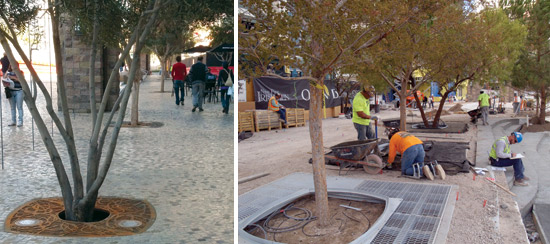Exterior Design Strategies for Placemaking Downtown
Building community or placemaking has become an important design element that bridges the gap between the design of a single building and the environment and landscape around the building. “Placemaking is a quiet movement that reimagines public spaces as the heart of every community, in every city. It's a transformative approach that inspires people to create and improve their public places. Placemaking strengthens the connection between people and the places they share,”1 according to the Project for Public Places, a leader in research and documentation of what makes great public spaces. Authors Jane Jacobs and William H. Whyte began to research and write about making great places in the 1960s. This movement has grown to be inclusive of both public and private spaces. The principles of placemaking are focused on inclusion and process. Key attributes include design that is attractive, safe, accessible, interactive, inclusive of the environment, and multi-generational.
Architects are consulting with communities to find ways to light urban spaces efficiently, preserve trees, and create “break-out” spaces for community events that give compelling reasons to be downtown. In California, New York, Illinois, Iowa, and Colorado, to name just a few, pop-up restaurants are reclaiming parking spaces for downtowns. This trend is made possible by new pedestal outdoor floor decking systems. The commercial sector is also finding value in the creation of outdoor gardens, street-side seating, rooftop bars, and dance floors. Health centers are using their rooftops for tennis, play areas, and running tracks, and the demand is growing for similar amenities on top of mixed-use housing projects.
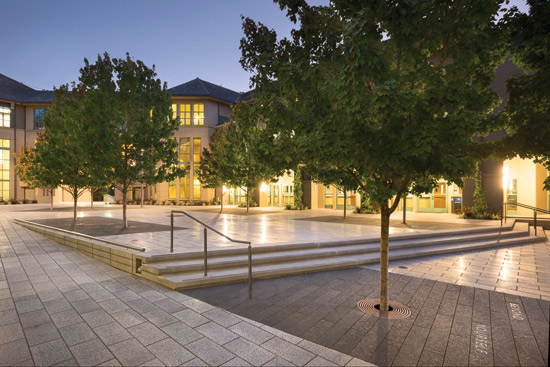
Photo courtesy of IRONSMITH
This plaza at the Haas School of Business at the University of California Berkeley used an innovative paver suspension system to allow room for shade trees to grow while preserving the open space.
Some of the tools that have been refined in recent years to add to the architect's toolkit include versatile roof deck pedestal systems, efficient LED lighting, and paver suspension systems that allow for the preservation of mature trees and compliance with the Americans with Disabilities Act. “The challenge to designers, owners, and communities is to preserve the character of public space while managing organic materials. Capturing public spaces through energy-efficient lighting, planting trees downtown, or creating garden paving systems require the integration of natural materials with mechanical systems. Successful outdoor places bring people together and help preserve culture and community,” says Paul Bambauer, president of IRONSMITH.
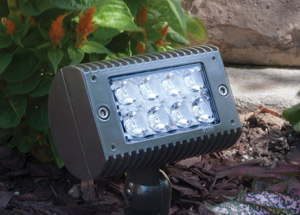
Photo courtesy of Kim Lighting
Innovative LED lighting can be placed in landscape areas to highlight and enhance plants and trees.
Integrating high-tech lighting, utility installation, and stormwater control requires the knowledge of both the micro—and the macro—climate of the specific location. “Because of the complexity of interactions in public spaces, daylighting, type of vegetation, outdoor signage, the impact of weather, daylight, and climate, designers must analyze many factors when considering lighting the outdoors. Sophisticated LED lighting systems can be calibrated to specific locations and are more sensitive to color renditions that highlight organic features. Energy-efficient LED systems will become standard in illuminating activities downtown while complying to Dark Sky ordinances and security concerns,” predicts Steve Wojno of Kim Lighting.
Each of these innovative products addresses the complexity and contradictions the designer faces while integrating organic materials into their placemaking. A review of some of these issues will aid the designer in avoiding some common mistakes.
Design For Micro-Climate
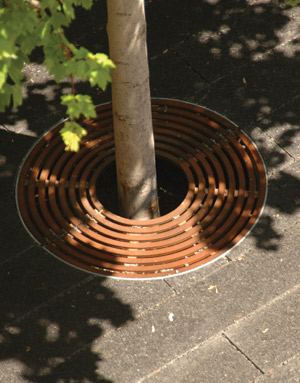
Photo courtesy of IRONSMITH
Custom trim rings for the Haas School of Business can be adjusted for tree growth.
Most designers are knowledgeable about the elements of climate. Temperature ranges, wind speed, solar aspect, and rainwater/snow volumes are all elements that are part of every initial site analysis. As the design professional digs deeper into a project, they analyze the human factors that impact design, traffic, public/private use of the building or public space, the adjacent buildings, and natural features that are in the immediate vicinity of the proposed project. Local, state, and/or national zoning codes may require stormwater treatment, tree or canopy shade calculations, lighting controls for “dark sky” preservation. In addition to these, an integrated approach includes the calculation for growth of organic materials, the color and intensity of lighting systems, and the sloped surfaces of uneven or deliberately canted roof and paving surfaces. The following is a review of some details to consider when drilling into the complexity of integrative design that is made less difficult by innovative paver suspension systems, LED lighting, and new decking systems.
Paver Suspension Systems That Preserve Mature Canopy Design
The microclimate of a public space is created by a variety of impacts caused by weather and orientation. These might include salt spray and snow collection in the winter, adjacent buildings or features that can create wind tunnels or too much or too little sun, water fountains, vehicle and pedestrian traffic. Creating the atmosphere of sun and light spatter or nighttime elegance and safety and defining a place for pedestrians to walk or dine can be a challenge.
In the past, the approach to outdoor design has been to strip a site of all vegetation and then replant. The disadvantage of this approach is that it may take many years to re-establish the ambience that mature trees bring to a site. In many cases, these new landscapes fail to capture the sense of place that can be developed using more mature trees.
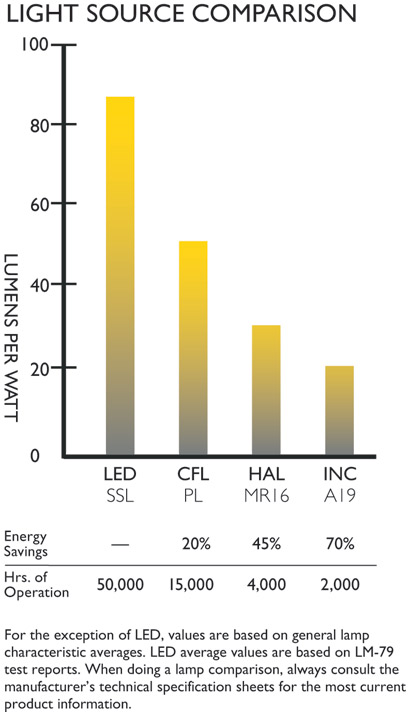
Chart courtesy of Kim Lighting
Comparison of energy-efficient LED lighting to other light sources.
Notice
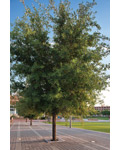
www.ironsmith.cc
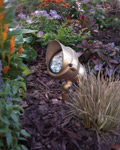
www.KimLighting.com
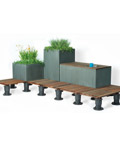
www.BisonIP.com





